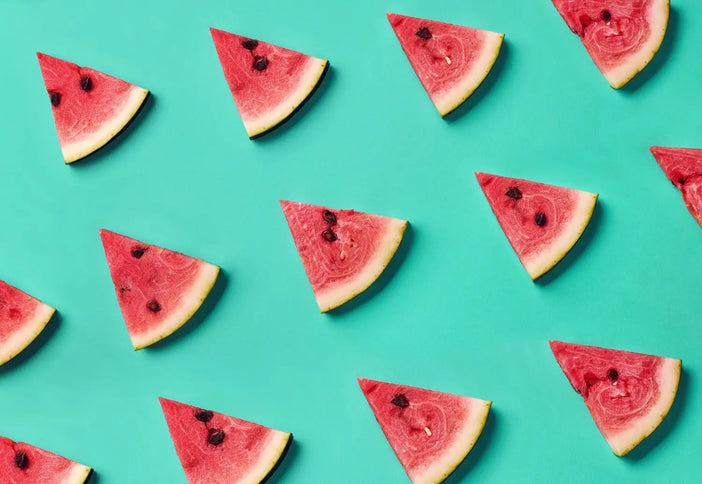Watermelon Day: high GI, kiss watermelon goodbye?

Even though eating watermelon is recognized as a staple in the American summer pastime, it is actually quite an international and diverse food! China is actually the number 1 producer of watermelon, and in places like China, the outer rind of the watermelon is used as a vegetable – stir-fried, stewed and often pickled. Pickled watermelon rind also is widespread in Russia. As a favorite around the world, it’s no wonder that we give it it’s own special day each August 3rd. But, what about the natural sugars in watermelon? Is it safe to enjoy with type 2? Let’s dive in.
Watermelon, GI and Type 2
If you live with diabetes, there really are no forbidden fruits as long as you follow a few recommendations. The GI is a useful tool for making dietary decisions. Take into consideration that fruits and fruit products with high GI scores can raise your blood sugar levels. Watermelon has a GI score of 76 and therefore should be eaten in moderation. What is moderation for watermelon? One serving size 154 grams or 1 cup of raw watermelon cubed or balled.
Serving Breakdown:
- 1 cup diced watermelon (152g): 0.6 grams fiber, 9.4 grams sugars, 11.5 grams total carbohydrates, 10.9 grams net carbohydrates
- 1 medium-sized wedge of watermelon (286g): 1.1 grams fiber, 18 grams sugars, 22 grams total carbohydrates, 21 grams net carbohydrates
GI Quick Guide: The glycemic index is a value assigned to foods based on how slowly or how quickly those foods cause increases in blood glucose levels. Foods low on the glycemic index (GI) scale tend to release glucose slowly and steadily. Foods high on the glycemic index release glucose rapidly. Low GI foods tend to foster weight loss, while foods high on the GI scale help with energy recovery after exercise, or to offset hypo- (or insufficient) glycemia.
When eating a high GI food, such as watermelon, combine it with low GI foods to balance the effect on your glucose levels. The GI of a food, and its impact on people with diabetes may change when you combine it with other foods such as quinoa, carrots, or nuts (check out our salad option below)!

Fruit or Veggie? Watermelon Salad
Despite the sweetness of this melon, did you know watermelon could be considered a fruit or a vegetable? Yes, it grows from a vine, has seeds and is sweet in flavor. However, it is actually a member of the gourd family like cucumbers, squash and pumpkins. Whatever you consider your watermelon, fruit or veggie, pairing your watermelon with other veggies, grains and protein you can create a beautiful meal!
Bringing you a new summer staple, this Watermelon Summer Salad with feta can be paired with a grilled protein such as salmon, chicken. However, this salad can become its own entire meal when you add cucumber, red onion, more arugula and a healthy grain such as farrow or whole grain sorghum. Tip: If you aren’t into mint use basil or cilantro (both delicious).
Ingredients
- 9 cups watermelon, cut in large circles with a melon baller
- 2 loose cups baby arugula
- 8 to 10 fresh spearmint leaves, chopped
- 8 ounce package feta cheese, crumbled in large chunks
Instructions
- Using a melon baller, prepare the melon into large balls. Set aside in a bowl until ready to serve.
- About 30 minutes before you’re ready to serve, drain the liquid from the bowl (I poured it into a cup and drank it!).
- Scatter half of the watermelon into a large, shallow serving bowl and scatter half of the arugula and feta on top, repeat with the remaining watermelon, arugula and feta then top everything with fresh mint.

Watermelon Day Takeaway
For many people with diabetes, carbohydrate counting helps limit carbohydrates to a healthy amount. Carb counting along with choosing healthy foods and maintaining a healthy weight may be enough to control diabetes and lower the risk for complications. Budgeting your carbs makes enjoying watermelon safe. When eating the right portion size and pairing your watermelon with other healthy low carb or low GI foods you should be able to enjoy watermelon this Tuesday.
If you have trouble controlling your blood sugar or want tighter control, you should talk with your health care provider about using the glycemic index as part of your action plan. Keep talking by joining and sharing in our facebook group - Winning Type 2 Diabetes Together. It is an ever-growing group of almost 50,000 diabetics who help each other, support each other, and laugh together! We want YOU to join us!





